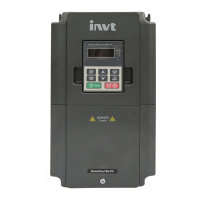Goodrive100-PV Series Solar Pumping VFD Safety precautions
3
(+) and (-) are DC power supply input terminals. R, S and T (L,N) are AC power supply
input terminals. U, V and W are output terminals. Please connect the input power cables
and motor cables with proper techniques; otherwise the damage to the VFD may occur.
1.3.2 Commissioning and running
Disconnect all power supplies applied to the VFD before the terminal
wiring and wait for at least the designated time after disconnecting the
power supply.
High voltage is present inside the VFD during running. Do not carry out
any operation except for the keypad setting.
The VFD cannot be used as “Emergency-stop device”.
If the VFD is used to break the motor suddenly, a mechanical braking
device should be provided.
Note:
Do not switch on or off the input power supply of the VFD frequently.
For VFDs that have been stored for a long time, check and fix the capacitance and try to
run it again before utilization.
Cover the front board before running, otherwise electric shock may occur.
1.3.3 Maintenance and replacement of components
Only qualified electricians are allowed to perform the maintenance,
inspection, and components replacement of the VFD.
Disconnect all power supplies to the VFD before the terminal wiring. Wait
for at least the time designated on the VFD after disconnection.
Take measures to avoid screws, cables and other conductive materials to
fall into the VFD during maintenance and component replacement.
Note:
Please select proper torque to tighten screws.
Keep the VFD, parts and components away from combustible materials during
maintenance and component replacement.
Do not carry out any isolation voltage-endurance test on the VFD and do not measure the
control circuit of the VFD by megameter.
1.3.4 Scrap treatment
There are heavy metals in the VFD. Deal with it as industrial effluent.
When the life cycle ends, the product should enter the recycling system.
Dispose of it separately at an appropriate collection point instead of
placing it in the normal waste stream.

